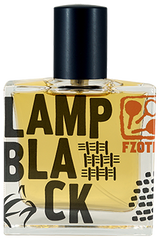Lampblack: The Smell of Ink

February is the month that feels like a never-ending snooze button, offering little to celebrate (Valentine's Day? Not my vibe!) and piles of tax documents to sort through. It's hibernation time for me. I'm up early, immersed in winter darkness, seizing the quiet hours for coffee, writing, and artistic endeavors.
Katherine May captures the magic of these early mornings in her book Wintering.
The inky hours are also for writing: the scratch and flow of pen on good paper, the stuttering chains of words that expand to fill pages and pages… Crucially, my sensible daytime self, bossy and overbearing, still slumbers. Without its overseeing eye, I can see different futures and make imaginative leaps.
Note that word, inky. Ink, my chosen medium, is a fragrance journey in its own right, with a long history both for human civilization and for me as an artist-perfumer.
Lampblack, my third perfume, materialized during a time when ink dominated my studio. A harmonious blend of dark, inky notes and bright, fruity citrus, Lampblack is a milestone in my artistic exploration—it launched my career as an entrepreneur. Luca Turin's four-star review of it in Perfumes: The Guide propelled my humble side hustle into a full-fledged job.
WHY INK SMELLS
The history of ink is rich and intertwined with the history of human creativity. The word "ink" comes from the Greek verb enkaiein, meaning 'to burn-in.' Black ink, developed by the ancient Egyptians 4500 years ago, was traditionally made from burnt organic matter—wood, animal bones, and even the soot collected from oil-burning lamps.
Yes, you read that right: for thousands of years, humans wrote their history and drew their art by collecting the "dirty" soot from lamps to make ink—we call this upcycling now.
This soot-based pigment, lampblack, carries a distinctive aroma, serving as the primary inspiration for my perfume. Lampblack pigment, like all burnt things, has a smell. My fragrance, Lampblack, is often classed as a "leather" perfume, but this is incorrect. It's only because leather and ink are closely related odors. Curious? Read on.
BURNT STUFF: INK, LEATHER & SMOKE
Since it's full of burnt stuff, the smell of ink is closely related to the smell of smoke. But actual, burning hot smoke is an extremely complex odor. Wood smoke, for instance, includes sweet and spicy molecules like vanillin and eugenol (a clove/carnation note) that are not part of the ink aroma profile.
Smoke also contains cresols and phenols, which lend medicinal, leathery, and inky aspects. Leather was traditionally treated with the tannins from the bark of trees, tannins which are high in phenols, so ink and leather have something in common.
Sorry to nerd out. Have I lost you?
All you need to know is that ink has the bracing medicinal/chemical note of leather, minus the animal note from the actual animal hide. It smells a little smokey, a little burnt, a little chemical/medicinal, but above all, it smells inky.
Those inky notes alone are off-putting, so for my ink-inspired fragrance, Lampblack, I chose to balance them with bright, fruity citrus notes at the top and cypriol in the base.
Cypriol (also called nagarmotha) is a root related to vetiver that has a woody, petroleum-like facet. Cypriol is used as an alternative to staggeringly expensive oud essential oil (most oud fragrances on the market cannot, for economic reasons, don't contain any actual oud oil). In Lampblack, the cypriol lends an oud aspect, but it also supports the ink accord.
Lampblack was my third perfume, but it became the foundation of my brand. Luca Turin, in his second edition of Perfumes: The Guide, gave it four stars and instantly catapulted my artist's side hustle to a whole new level. You can try it for yourself in our Woody Palette.
Shine brightly!
–Bruno



